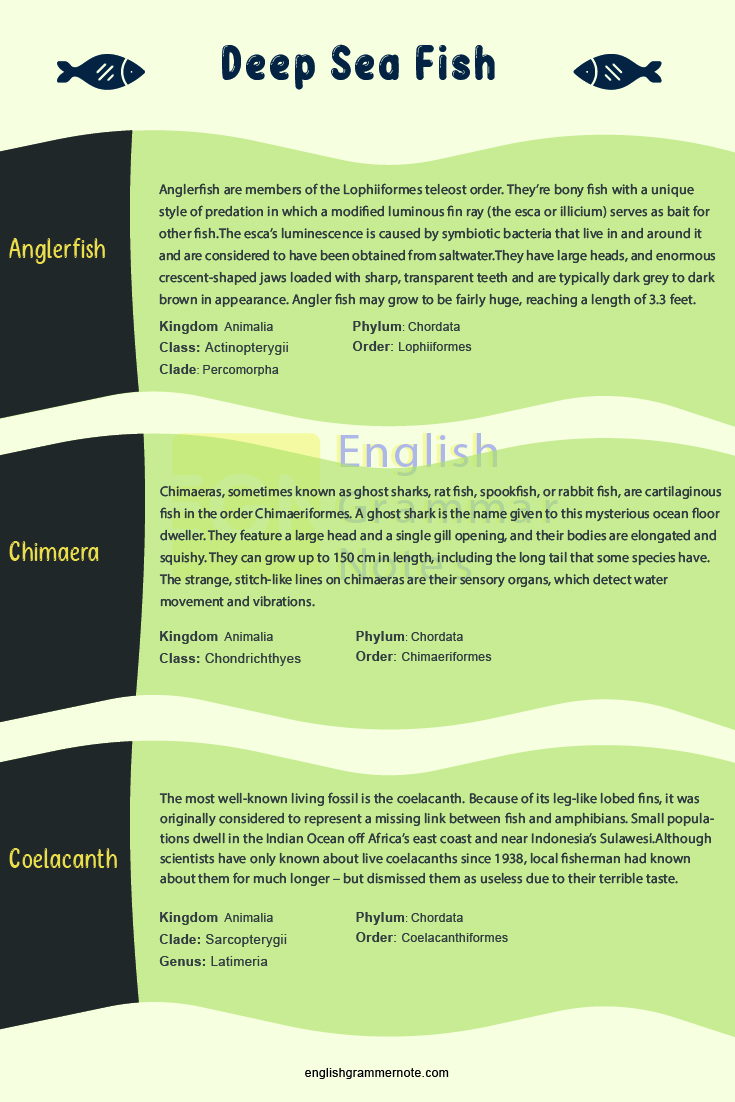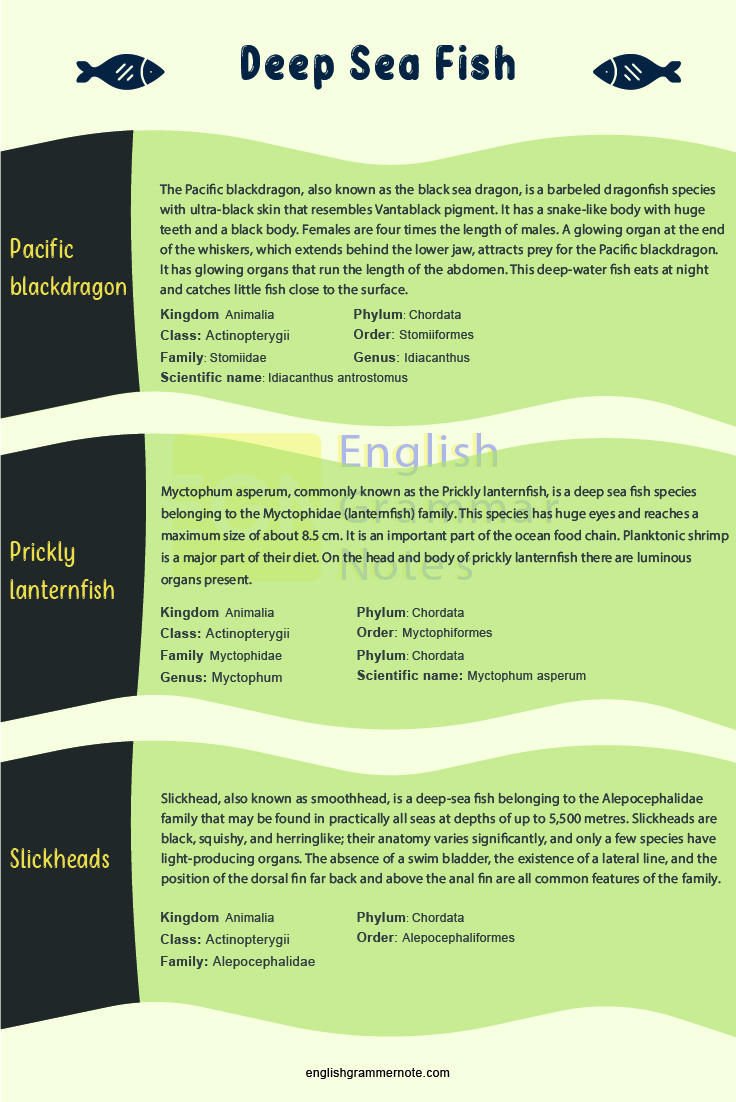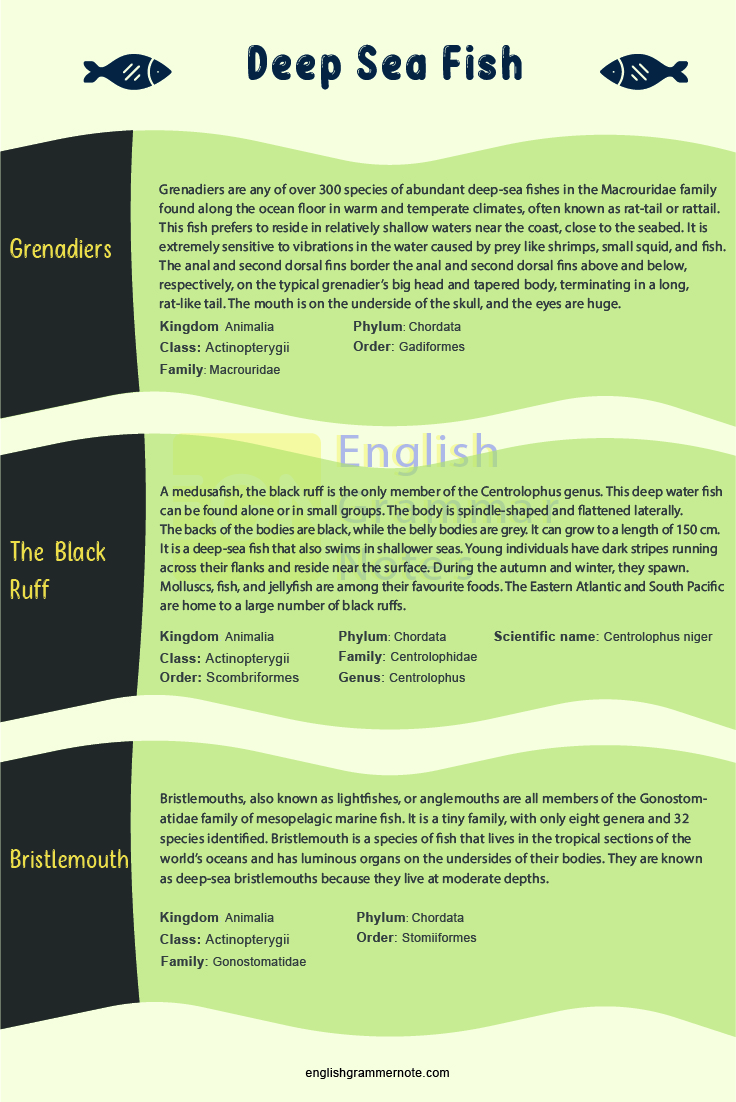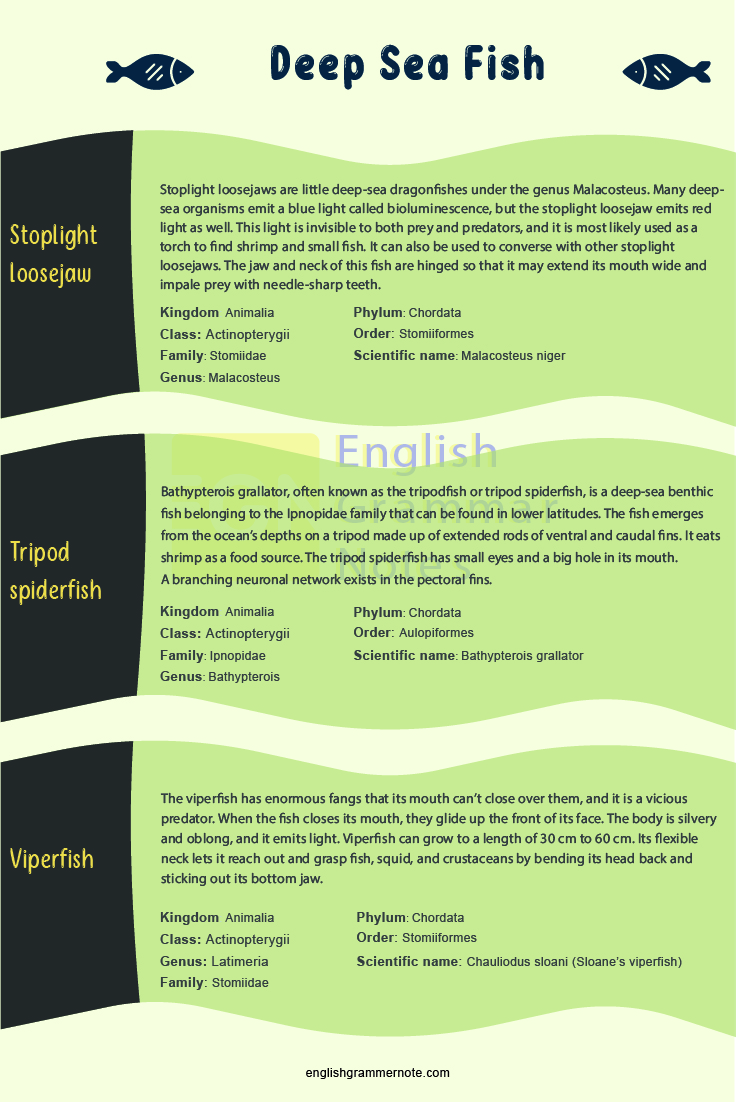Deep Sea Fish: Underneath the sea’s crushing blackness, an ecosystem has evolved to flourish in the absence of sunlight and warmth. It’s a universe full of organisms that have developed unique adaptations to survive in such a harsh environment. This deep-sea fish list has the names of such unusual fishes that have unique and sometimes scary appearances.
Deep sea fish survive in harsh environments. They are exposed to intense pressure, rapid temperature variations, and a dark atmosphere. You may want to know the names of deep sea fish to eat or just to increase your knowledge about the underwater organisms; this list will come in handy for you in all the possible scenarios.
Study the most important English Vocabulary Words identified by our experts and learn the right vocabulary to use in your day to day conversations
You will be surprised to know about these rare deep-sea creatures as how they have modified themselves to adapt to these adverse environmental conditions and how they function to stay alive in the deep sea. Hence, we have gathered a list of deep-sea fish along with their descriptions and pictures in this article.
List of Deep Sea Fish
Name of Deep Sea Fish
- Anglerfish
- Black seadevil
- Bristlemouth
- Chimaera
- Coelacanth
- Fangtooth
- Footballfish
- Grenadier
- Pacific blackdragon
- Prickly lanternfish
- Slickheads
- Stoplight loosejaw
- The black ruff
- Tripod spiderfish
- Viperfish
Description of the Deep Sea Fish on the list
Anglerfish
Anglerfish are members of the Lophiiformes teleost order. They’re bony fish with a unique style of predation in which a modified luminous fin ray (the esca or illicium) serves as bait for other fish.
The esca’s luminescence is caused by symbiotic bacteria that live in and around it and are considered to have been obtained from saltwater.
They have large heads, and enormous crescent-shaped jaws loaded with sharp, transparent teeth and are typically dark grey to dark brown in appearance. Angler fish may grow to be fairly huge, reaching a length of 3.3 feet.
The majority, on the other hand, are much tiny, typically less than a foot long.
| Kingdom | Animalia |
| Phylum | Chordata |
| Class | Actinopterygii |
| Clade | Percomorpha |
| Order | Lophiiformes |
Black seadevil
The Melanocetidae family of deep-sea lophiiform fishes includes black seadevils. Melanocetus is the genus that contains the five species that have been discovered. They can be found in the Atlantic, Indian, and Pacific Oceans in tropical to temperate waters.
Females have large fangs and a stalked light organ between their eyes. Males are smaller and have large nostrils that they utilise to find their partners in the dark.
Once a male has found a female, it uses its teeth to attach itself to her bottom. It lives as a parasite on the female, eating on her until it is needed to fertilise the eggs.
| Kingdom | Animalia |
| Phylum | Chordata |
| Class | Actinopterygii |
| Order | Lophiiformes |
| Family | Melanocetidae |
| Genus | Melanocetus |

Bristlemouth
Bristlemouths, also known as lightfishes, or anglemouths are all members of the Gonostomatidae family of mesopelagic marine fish.
It is a tiny family, with only eight genera and 32 species identified. Bristlemouth is a species of fish that lives in the tropical sections of the world’s oceans and has luminous organs on the undersides of their bodies. They are known as deep-sea bristlemouths because they live at moderate depths.
| Kingdom | Animalia |
| Phylum | Chordata |
| Class | Actinopterygii |
| Order | Stomiiformes |
| Family | Gonostomatidae |
Chimaera
Chimaeras, sometimes known as ghost sharks, rat fish, spookfish, or rabbit fish, are cartilaginous fish in the order Chimaeriformes. A ghost shark is the name given to this mysterious ocean floor dweller.
They feature a large head and a single gill opening, and their bodies are elongated and squishy. They can grow up to 150 cm in length, including the long tail that some species have. The strange, stitch-like lines on chimaeras are their sensory organs, which detect water movement and vibrations.
| Kingdom | Animalia |
| Phylum | Chordata |
| Class | Chondrichthyes |
| Order | Chimaeriformes |
Coelacanth
The most well-known living fossil is the coelacanth. Because of its leg-like lobed fins, it was originally considered to represent a missing link between fish and amphibians. Small populations dwell in the Indian Ocean off Africa’s east coast and near Indonesia’s Sulawesi.
Although scientists have only known about live coelacanths since 1938, local fisherman had known about them for much longer – but dismissed them as useless due to their terrible taste.
| Kingdom | Animalia |
| Phylum | Chordata |
| Clade | Sarcopterygii |
| Order | Coelacanthiformes |
| Genus | Latimeria |

Fangtooth
The fangtooth is a tiny fish with a compressed body laterally. Fangtooths have enormous heads and disproportionately long sharp teeth, despite their diminutive stature.
When their jaws close, two sockets have formed on the sides of their brains to accommodate their teeth. The fangtooth’s enormous fangs allow it to kill fish much larger than itself.
| Kingdom | Animalia |
| Phylum | Chordata |
| Class | Actinopterygii |
| Order | Trachichthyiformes |
| Family | Anoplogastridae |
| Genus | Anoplogaster |
| Scientific name | Anoplogaster cornuta |
Footballfish
The footballfish, which is about the size of a football and coated with spines, is approximately the size of a football. It also has branches that grow out from the top of its head and end in tiny bright lights. These lights attract prey, which is then snatched up by the footballfish’s sharp-toothed mouth.
They can be found in the Atlantic, Indian, and Pacific Oceans’ tropical and subtropical waters. There are around 22 species in the family, all of which belong to the Himantolophus genus.
| Kingdom | Animalia |
| Phylum | Chordata |
| Class | Actinopterygii |
| Order | Lophiiformes |
| Family | Himantolophidae |
| Genus | Himantolophus |
| Scientific name | Himantolophus groenlandicus (Atlantic footballfish) |
Grenadier
Grenadiers are any of over 300 species of abundant deep-sea fishes in the Macrouridae family found along the ocean floor in warm and temperate climates, often known as rat-tail or rattail.
This fish prefers to reside in relatively shallow waters near the coast, close to the seabed. It is extremely sensitive to vibrations in the water caused by prey like shrimps, small squid, and fish.
The anal and second dorsal fins border the anal and second dorsal fins above and below, respectively, on the typical grenadier’s big head and tapered body, terminating in a long, rat-like tail. The mouth is on the underside of the skull, and the eyes are huge.
| Kingdom | Animalia |
| Phylum | Chordata |
| Class | Actinopterygii |
| Order | Gadiformes |
| Family | Macrouridae |
Pacific blackdragon
The Pacific blackdragon, also known as the black sea dragon, is a barbeled dragonfish species with ultra-black skin that resembles Vantablack pigment. It has a snake-like body with huge teeth and a black body. Females are four times the length of males.
A glowing organ at the end of the whiskers, which extends behind the lower jaw, attracts prey for the Pacific blackdragon. It has glowing organs that run the length of the abdomen. This deep-water fish eats at night and catches little fish close to the surface.
| Kingdom | Animalia |
| Phylum | Chordata |
| Class | Actinopterygii |
| Order | Stomiiformes |
| Family | Stomiidae |
| Genus | Idiacanthus |
| Scientific name | Idiacanthus antrostomus |
Prickly lanternfish
Myctophum asperum, commonly known as the Prickly lanternfish, is a deep sea fish species belonging to the Myctophidae (lanternfish) family. This species has huge eyes and reaches a maximum size of about 8.5 cm.
It is an important part of the ocean food chain. Planktonic shrimp is a major part of their diet. On the head and body of prickly lanternfish there are luminous organs present.
| Kingdom | Animalia |
| Phylum | Chordata |
| Class | Actinopterygii |
| Order | Myctophiformes |
| Family | Myctophidae |
| Genus | Myctophum |
| Scientific name | Myctophum asperum |

Slickheads
Slickhead, also known as smoothhead, is a deep-sea fish belonging to the Alepocephalidae family that may be found in practically all seas at depths of up to 5,500 metres.
Slickheads are black, squishy, and herringlike; their anatomy varies significantly, and only a few species have light-producing organs. The absence of a swim bladder, the existence of a lateral line, and the position of the dorsal fin far back and above the anal fin are all common features of the family.
| Kingdom | Animalia |
| Phylum | Chordata |
| Class | Actinopterygii |
| Order | Alepocephaliformes |
| Family | Alepocephalidae |
Stoplight loosejaw
Stoplight loosejaws are little deep-sea dragonfishes under the genus Malacosteus. Many deep-sea organisms emit a blue light called bioluminescence, but the stoplight loosejaw emits red light as well. This light is invisible to both prey and predators, and it is most likely used as a torch to find shrimp and small fish.
It can also be used to converse with other stoplight loosejaws. The jaw and neck of this fish are hinged so that it may extend its mouth wide and impale prey with needle-sharp teeth.
| Kingdom | Animalia |
| Phylum | Chordata |
| Class | Actinopterygii |
| Order | Stomiiformes |
| Family | Stomiidae |
| Genus | Malacosteus |
| Scientific name | Malacosteus niger |
The black ruff
A medusafish, the black ruff is the only member of the Centrolophus genus. This deep water fish can be found alone or in small groups. The body is spindle-shaped and flattened laterally.
The backs of the bodies are black, while the belly bodies are grey. It can grow to a length of 150 cm. It is a deep-sea fish that also swims in shallower seas.
Young individuals have dark stripes running across their flanks and reside near the surface. During the autumn and winter, they spawn. Molluscs, fish, and jellyfish are among their favourite foods. The Eastern Atlantic and South Pacific are home to a large number of black ruffs.
| Kingdom | Animalia |
| Phylum | Chordata |
| Class | Actinopterygii |
| Order | Scombriformes |
| Family | Centrolophidae |
| Genus | Centrolophus |
| Scientific name | Centrolophus niger |

Tripod spiderfish
Bathypterois grallator, often known as the tripodfish or tripod spiderfish, is a deep-sea benthic fish belonging to the Ipnopidae family that can be found in lower latitudes.
The fish emerges from the ocean’s depths on a tripod made up of extended rods of ventral and caudal fins. It eats shrimp as a food source. The tripod spiderfish has small eyes and a big hole in its mouth. A branching neuronal network exists in the pectoral fins.
| Kingdom | Animalia |
| Phylum | Chordata |
| Class | Actinopterygii |
| Order | Aulopiformes |
| Family | Ipnopidae |
| Genus | Bathypterois |
| Scientific name | Bathypterois grallator |
Viperfish
The viperfish has enormous fangs that its mouth can’t close over them, and it is a vicious predator. When the fish closes its mouth, they glide up the front of its face. The body is silvery and oblong, and it emits light.
Viperfish can grow to a length of 30 cm to 60 cm. Its flexible neck lets it reach out and grasp fish, squid, and crustaceans by bending its head back and sticking out its bottom jaw.
| Kingdom | Animalia |
| Phylum | Chordata |
| Class | Actinopterygii |
| Order | Stomiiformes |
| Family | Stomiidae |
| Genus | Chauliodus |
| Scientific name | Chauliodus sloani (Sloane’s viperfish) |
